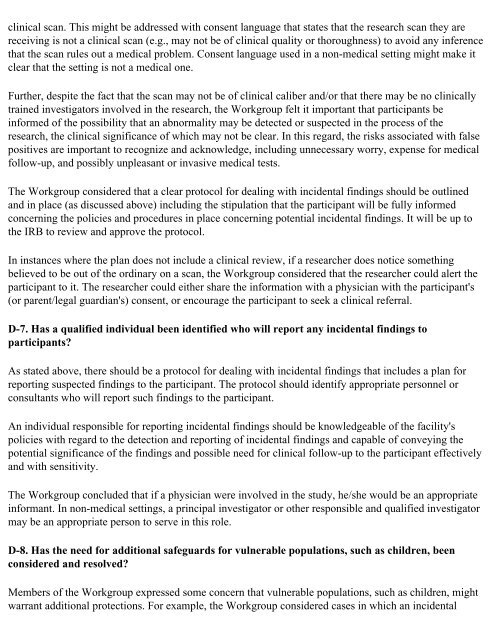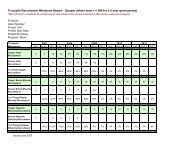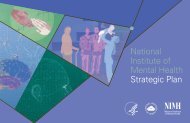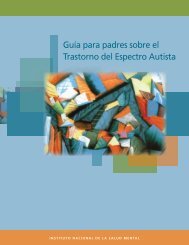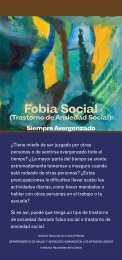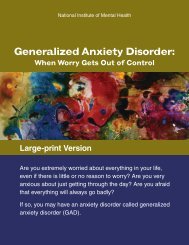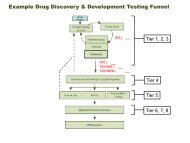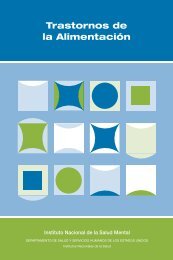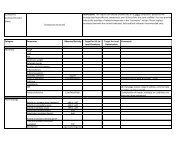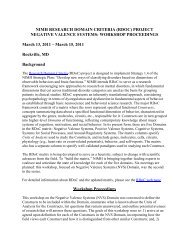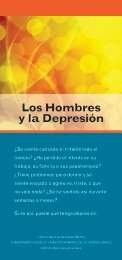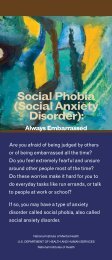MRI Research Safety and Ethics: Points to Consider - NIMH
MRI Research Safety and Ethics: Points to Consider - NIMH
MRI Research Safety and Ethics: Points to Consider - NIMH
Create successful ePaper yourself
Turn your PDF publications into a flip-book with our unique Google optimized e-Paper software.
clinical scan. This might be addressed with consent language that states that the research scan they arereceiving is not a clinical scan (e.g., may not be of clinical quality or thoroughness) <strong>to</strong> avoid any inferencethat the scan rules out a medical problem. Consent language used in a non-medical setting might make itclear that the setting is not a medical one.Further, despite the fact that the scan may not be of clinical caliber <strong>and</strong>/or that there may be no clinicallytrained investiga<strong>to</strong>rs involved in the research, the Workgroup felt it important that participants beinformed of the possibility that an abnormality may be detected or suspected in the process of theresearch, the clinical significance of which may not be clear. In this regard, the risks associated with falsepositives are important <strong>to</strong> recognize <strong>and</strong> acknowledge, including unnecessary worry, expense for medicalfollow-up, <strong>and</strong> possibly unpleasant or invasive medical tests.The Workgroup considered that a clear pro<strong>to</strong>col for dealing with incidental findings should be outlined<strong>and</strong> in place (as discussed above) including the stipulation that the participant will be fully informedconcerning the policies <strong>and</strong> procedures in place concerning potential incidental findings. It will be up <strong>to</strong>the IRB <strong>to</strong> review <strong>and</strong> approve the pro<strong>to</strong>col.In instances where the plan does not include a clinical review, if a researcher does notice somethingbelieved <strong>to</strong> be out of the ordinary on a scan, the Workgroup considered that the researcher could alert theparticipant <strong>to</strong> it. The researcher could either share the information with a physician with the participant's(or parent/legal guardian's) consent, or encourage the participant <strong>to</strong> seek a clinical referral.D-7. Has a qualified individual been identified who will report any incidental findings <strong>to</strong>participants?As stated above, there should be a pro<strong>to</strong>col for dealing with incidental findings that includes a plan forreporting suspected findings <strong>to</strong> the participant. The pro<strong>to</strong>col should identify appropriate personnel orconsultants who will report such findings <strong>to</strong> the participant.An individual responsible for reporting incidental findings should be knowledgeable of the facility'spolicies with regard <strong>to</strong> the detection <strong>and</strong> reporting of incidental findings <strong>and</strong> capable of conveying thepotential significance of the findings <strong>and</strong> possible need for clinical follow-up <strong>to</strong> the participant effectively<strong>and</strong> with sensitivity.The Workgroup concluded that if a physician were involved in the study, he/she would be an appropriateinformant. In non-medical settings, a principal investiga<strong>to</strong>r or other responsible <strong>and</strong> qualified investiga<strong>to</strong>rmay be an appropriate person <strong>to</strong> serve in this role.D-8. Has the need for additional safeguards for vulnerable populations, such as children, beenconsidered <strong>and</strong> resolved?Members of the Workgroup expressed some concern that vulnerable populations, such as children, mightwarrant additional protections. For example, the Workgroup considered cases in which an incidental


